Stock Market Investors Roller Coaster Ride Hit by Bad U.S. Jobs Data
Stock-Markets / Financial Markets 2009 Jul 05, 2009 - 08:13 AM GMT “Words from the Wise” this week again comes to you in a shortened format as I am still on the road in Europe (also see my post “Gone A.W.O.L. - to Slovenia and Switzerland“) and do not have access to my normal research resources. Although only brief commentary is provided, a full dose of excerpts from interesting news items and quotes from market commentators is included.
“Words from the Wise” this week again comes to you in a shortened format as I am still on the road in Europe (also see my post “Gone A.W.O.L. - to Slovenia and Switzerland“) and do not have access to my normal research resources. Although only brief commentary is provided, a full dose of excerpts from interesting news items and quotes from market commentators is included.
The holiday-shortened week saw pundits pondering the depth of the economic rabbit hole as the curtain closed on the second quarter. As investors vacillated, most financial markets were characterized by a roller-coaster ride. Friday’s worse-than-expected US jobs data left no doubt that the economy was in recession.
Given the economic malaise, it is safe to say that there have probably been better fourth of July celebrations than this weekend’s …
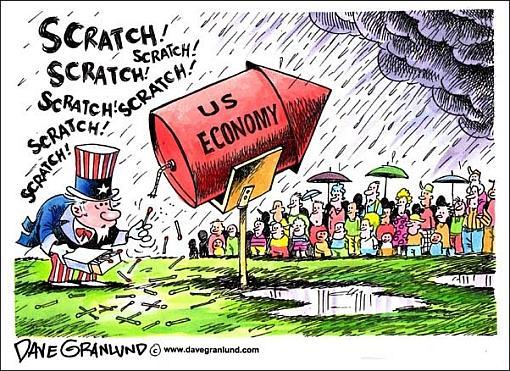
Source:Dave GranlundThe past week’s performance of the major asset classes is summarized by the chart below - a set of numbers that indicating that a degree of risk aversion has crept back into financial markets.
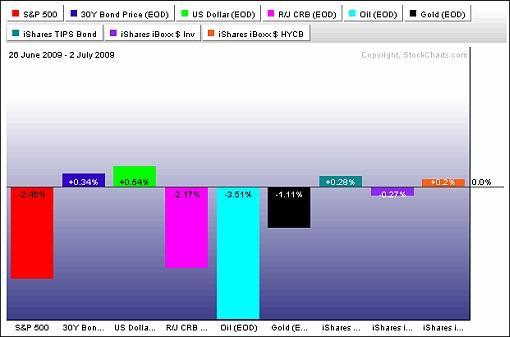
Source: StockCharts.com
Looking at the quarterly performance of the same asset classes, the picture is quite different from the chart above, with risky assets putting in a phenomenal performance to the detriment of the traditional safe havens such as the US dollar and government bonds.
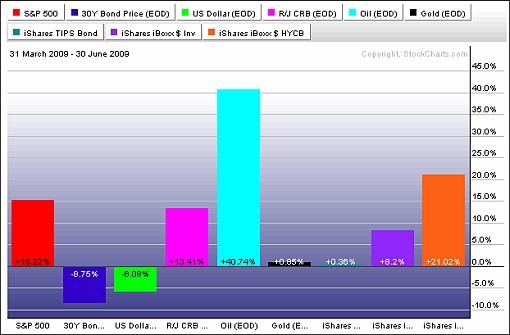
Source: StockCharts.com
A summary of the movements of major stock markets for the past week, as well as various other measurement periods, is given below. The weekly gains/losses camouflage the fact that many indices experienced a rather bumpy ride during the course of the week.
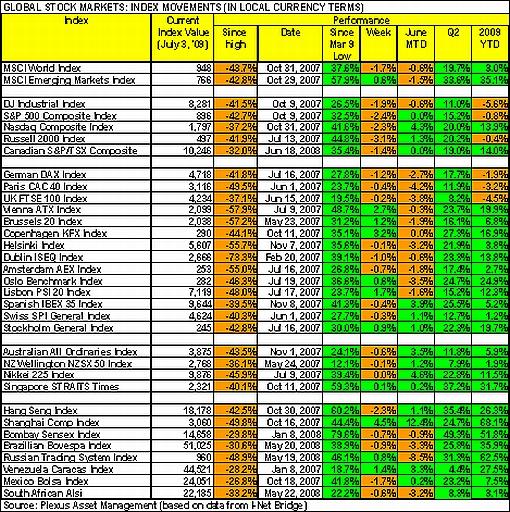
Stock market returns for the week ranged from top performers Egypt (+8.9%), Uganda (+7.9%), Bangladesh (+6.3%), Pakistan (+6.1%) and China (+5.5%) to Slovakia (-9.3%), Croatia (-8.7%), Vietnam (-5.6%), Mauritius (-4.0%) and Hungary (-3.6%) at the other end of the scale. Emerging markets make up all ten of the best-performing stock indices so far in 2009, led by Peru, Sri Lanka and China. (Click here to access a complete list of global stock market movements, as supplied by Emerginvest.)
John Nyaradi (Wall Street Sector Selector) reports that as far as exchange-traded funds (ETFs) are concerned, the winners for the week included iShares MSCI Turkey Index (TUR) (+5.4%), iShares MSCI South Africa Index (EZA) (+4.5%) and PowerShares Private Equity Portfolio (PSP) (+4.4%). On the other side of the performance spectrum, laggards were centered in the broader commodity category, including US Natural Gas (UNG) (-6.8%), iShares Silver Trust (SLV) (-3.9%) and PowerShares DB Commodity (DBC) (‑3.7%).
The quote du jour this week comes from Bill King, writer of The King Report, and is related to Wall Street pay approaching 2007’s record levels, as reported by The Wall Street Journal. King remarked: “Will Ben, Hank, Little Timmy and Congressional leaders explain to the American people how it is possible for Wall Street to have near-record remuneration AFTER the US taxpayers were put on the hook for about $12 trillion of guarantees to The Street? And will they explain to Americans that while Street insiders ‘earn’ record pay they must suffer a severe recession or depression, possibly record future inflation, collapsing home values, job losses and an income contraction?”
Next, a quick textual analysis of my week’s reading. No surprises here, with all the usual suspects such as “market”, “banks”, “economy” and “financial” featuring prominently. Interestingly, “China” also moved up the ranks as its economy seems to be on a strong growth path.
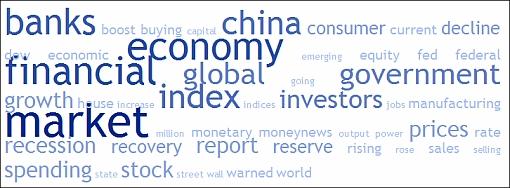
Back to the stock markets: the key moving average levels for the major US indices are given in the table below. With the exception of the Nasdaq Composite Index, the indices are all trading marginally below the 50-day moving average. Whereas the S&P 500 Index, Nasdaq Composite Index and Russell 2000 Index are trading above their respective 200-day lines, the Dow Jones Industrial Average and the Dow Jones Transportation Index are a notch below this key line. In order for a major uptrend to manifest itself, an upturn in the 200-day average itself also needs to take place.
Click here or on the table below for a larger image.

For more about key levels and the most likely short-term direction of the S&P 500 Index, Adam Hewison of INO.com prepared another of his popular technical analyses, arguing that one should be on the sidelines in this market. Click here to access the short presentation. (The analysis was done on Tuesday, but is still as relevant today as it was a few days ago.)
Richard Russell, veteran publisher of the 50-year-old Dow Theory Letters, remains in the bearish camp, saying: “Lowry’s Buying Power Index as of yesterday [Wednesday] was only 6 points above its level of March 9. That puts the market on very thin ice. It means that the desire to buy stocks has been steadily fading. All that’s needed now is a rise in selling pressure, and this market will unravel.
“Every day I compute the span between Lowry’s Buying Power Index and their Selling Pressure Index. The wider the span, the more bearish the situation. Yesterday the span closed at 872, the widest since March 9. This is the weakest reading of the entire rally. Extreme caution is warranted.”
Over in London, David Fuller (Fullermoney) commented as follows: “In terms of timing, now that we have seen big rallies off the lows, I would wait until investors are clearly fearful once again before adding further capital to stock markets. … if one was unprepared to ride out a stock market correction, then it was time to take some money off the table while prices were still firm.
“Meanwhile, I remain cautious, regarding a further stock market reaction and consolidation in response to the 14-week surge from the March lows as at least a 50/50 possibility. Moreover, this could easily develop into a correction, including base formation extension for lagging OECD country markets.”
In my opinion, US stock markets are mapping out a base development formation, whereas a number of emerging markets have already bottomed out and subsequently confirmed primary uptrends. However, in the short term it is quite likely that markets could consolidate further and possibly retrace more of the prior gains.
For more discussion on the direction of stock markets, see my recent posts “Video-o-rama: Roller-coaster ride into the long weekend“, “Barron’s Confidence Index points to bottoming of equities“, “Job losses in perspective“, “Monthly performance round-up: Road to recovery (June 30, 2009)“, “Stock market performance during economic cycles” and “Consider the components of equity returns“.
Economy
“The global Business Confidence Survey results at the end of June were the strongest they have been since last October. Expectations regarding the outlook toward the end of this year jumped last week to their highest level since the summer of 2006,” said the latest Survey of Business Confidence of the World conducted by Moody’s Economy.com. “Sentiment remains consistent with a continued global recession, but the downturn is quickly moderating.”
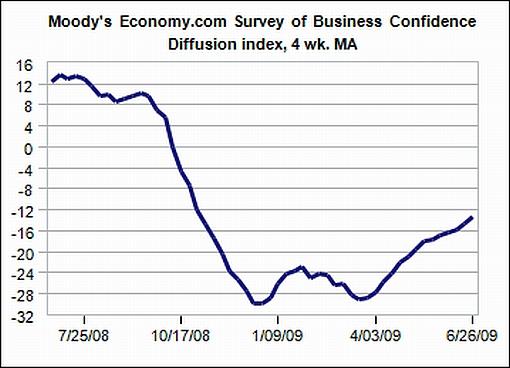
Source: Moody’s Economy.com
Moving to the Far East, the Japanese Tankan Survey’s index of current conditions among large manufacturers improved to -48 in the second quarter from -58 in the first quarter. The rise of 10 percentage points is the first improvement since the fourth quarter of 2007 and follows the worst reading on record during the first quarter.
In Europe, the European Central Bank (ECB) left its monetary policy unchanged as expected. It has kept its key policy interest rate at a historical low of 1% since May. However, the Swedish central bank, the Riksbank, reduced its repo rate from 0.5% to 0.25% and also cut the deposit rate to -0.25%, effectively charging savers interest on deposits.
A snapshot of the week’s US economic data is provided below. (Click on the dates to see Northern Trust’s assessment of the various data releases.)
Thursday, July 2
• June labor market report - details less bearish than headlines
Wednesday, July 1
• ISM Factory Survey - improving at a gradual pace
• Auto Sales fell slightly in June, but Q2 sales rose
• Pending Home Sales Index advances for fourth straight month
• Residential Construction remains weak; outlook Non-Residential Construction Spending is fuzzy
Tuesday, June 30
• Case-Shiller Home Price Index - home price declines are moderating
• Consumer Confidence Index slips in June
Also, according to Bloomberg, delinquency rates on the least risky mortgages more than doubled in the first quarter from a year earlier, climbing to 2.9% through March 31 from 1.1% at the same point in 2008.
Summarizing the US economic outlook, BCA Research said: “All eyes will be on the US consumer sector in the coming months. We are cautiously optimistic that a sub-par economic recovery will get under way in the second half of the year, allowing the riskier asset classes such as stocks, corporate bonds and commodities to outperform Treasuries and cash. However, there will be plenty of volatility and the main risk is that the mild consumer recovery we expect is delayed, serving to reinforce cost-cutting pressures in the business sector.”
Week’s economic reports
Click here for the week’s economy in pictures, courtesy of Jake of EconomPic Data.
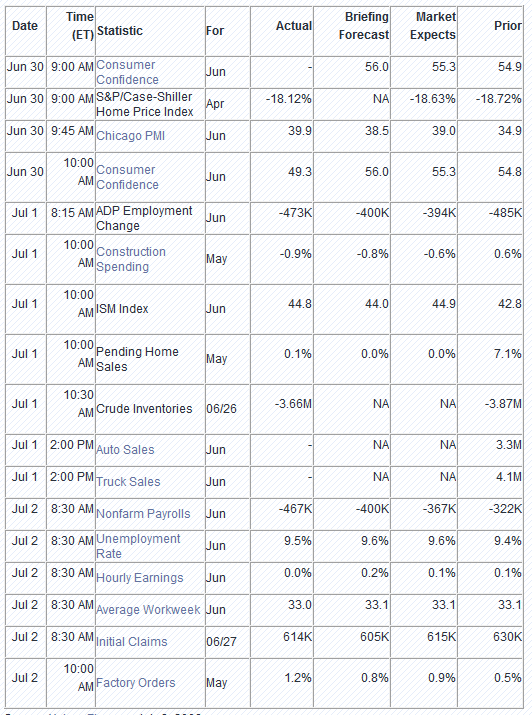
Source: Yahoo Finance, July 3, 2009.
Across the pond, the Bank of England (BoE) will make an interest rate announcement on Thursday (July 9), while in the US economic highlights for the week include the following:
Monday, July 6
ISM Services
Wednesday, July 8
Consumer credit
Thursday, July 9
Initial jobless claims
Wholesale Inventories
Friday, July 10
Trade balance
University of Michigan Consumer Confidence
Click here for a summary of Wachovia’s weekly economic and financial commentary.
Markets
The performance chart obtained from the Wall Street Journal Online shows how different global financial markets performed during the past week.
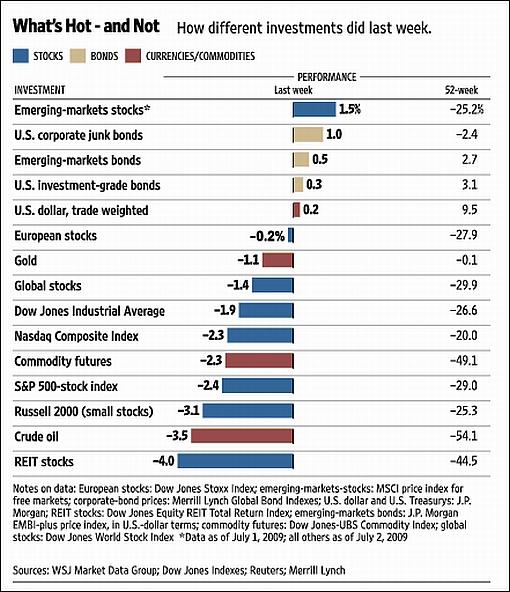
Source: Wall Street Journal Online, July 3, 2009.
Who is to blame for the financial mess the world finds itself in? There are many possible culprits, ranging from Alan Greenspan and the Federal Reserve to the rating agencies, the big Wall Street firms, structured investment vehicles, and so on. Dan Quayle offered one of the most original (and inconveniently true) suggestions: “Bank failures are caused by depositors who don’t deposit enough money to cover losses due to mismanagement.” (Hat tip: Tim Price.) Hopefully the news items and quotes from market commentators included in the “Words from the Wise” review will keep Investment Postcard readers on track in these crazy times.
For my American friends (the bulk of my readers), I hope you have had happy and safe fourth of July celebrations and enjoyed the fireworks.
That’s the way it looks from Veysonnaz, a quaint Alpine village in the south-western part of Switzerland where I will be spending the next week. (For short comments - maximum 140 characters - on topical economic and market issues, web links and graphs, you can follow me on Twitter by clicking here.)

Source: Larry Wright, July 3, 2009.
Barry Ritholtz (The Big Picture): Who is to blame
“Who and what was at fault in the entire debacle, from housing to credit to collapse? In what order would you assess the blame?
“In Bailout Nation (Chapter 19) my list went something like this:
1. Federal Reserve Chairman Alan Greenspan
2. The Federal Reserve (in its role of setting monetary policy)
3. Senator Phil Gramm
4-6. Moody’s Investors Service, Standard & Poor’s, and Fitch Ratings (rating agencies)
7. The Securities and Exchange Commission (SEC)
8-9. Mortgage originators and lending banks
10. Congress
11. The Federal Reserve again (in its role as bank regulator)
12. Borrowers and home buyers
13-17. The five biggest Wall Street firms (Bear Stearns, Lehman Brothers, Merrill Lynch, Morgan Stanley, and Goldman Sachs) and their CEOs
18. President George W. Bush
19. President Bill Clinton
20. President Ronald Reagan
21-22. Treasury Secretary Henry Paulson
23-24. Treasury Secretaries Robert Rubin and Lawrence Summers
25. FOMC Chief Ben Bernanke
26. Mortgage brokers
27. Appraisers (the dishonest ones)
28. Collateralized debt obligation (CDO) managers (who produced the junk) 29. Institutional investors (pensions, insurance firms, banks, etc.) for buying the junk
30-31. Office of the Comptroller of the Currency (OCC); Office of Thrift
Supervision (OTS)
32. State regulatory agencies
33. Structured investment vehicles (SIVs)/hedge funds for buying the junk
“Several names were omitted for reasons of avoiding repetition: CEOs of major banks and investment firms, the crony boards, the AWOL mutual funds. While the list in chapter 19 is somewhat incomplete, the book as whole is not.”
Source: Barry Ritholtz, The Big Picture, June 29, 2009.
CNN Money: Lawmakers attack Fed for being too secretive
“US lawmakers, during a hearing Thursday on the central bank’s role in Bank of America’s acquisition of Merrill Lynch, attacked the Federal Reserve as a secret agency unworthy of new enhanced regulatory powers.
“‘It’s time to yank the shroud off the Fed and shine some light on these events,’ said US House Committee on Oversight and Government Reform Chairman Edolphus Towns, D-NY, who in an opening statement repeatedly described the Fed as being ’shrouded in secrecy’.
“‘I believe that before Congress acts on the president’s financial services reform proposal, we need to have a thorough understanding of what caused the current financial crisis and how the federal government responded.’
“The heated congressional hearing got under way Thursday with Federal Reserve Chairman Ben Bernanke defending the central bank’s role in negotiations with Bank of America (BAC) and with members of the House Government Reform committee expressing skepticism of the Fed’s decisions.
“Usually, the Fed chief goes to Capitol Hill to take questions on monetary policy and the economy. But the economy was barely touched on at Thursday’s hearing.
“Instead, lawmakers criticized the Fed as an agency that has too much power and yet too little transparency and questioned whether the Fed should become the uber regulator of the financial system envisioned by the Obama administration.
“Bernanke, in his first congressional appearance since the administration rolled out its controversial regulatory-revamp proposal, defended the planned overhaul of US financial rules. It’s clear something has to be done to prevent firms from growing so big that they pose a risk to the financial system, Bernanke said.
“‘Too big to fail is not a policy. It’s a major problem,’ he said. ‘I hope the system will be changed.’
“Lawmakers are reluctant to boost the Fed’s powers. Even though it could help prevent companies from becoming too-big-to-fail, critics have argued that the central bank didn’t do enough before the crisis began to protect consumers and discourage firms from taking on riskier strategies that led to the credit crunch.
“Bernanke, however, said the administration’s plan for overhauling US financial rules won’t greatly boost the central bank’s authorities.”
Source: Maya Jackson Randall, CNN Money, June 25, 2009.
Fox News: Mr. Sunshine? Ron Paul wins support to audit Fed Reserve
“All of a sudden, Congress is paying close attention to Ron Paul.
“The feisty congressman from Texas, whose insurgent ‘Ron Paul Revolution’ presidential campaign rankled Republican leaders last year, now has the GOP House leadership on his side - backing a measure that generated paltry support when he first introduced it 26 years ago.
“Paul, as of Tuesday, has won 245 co-sponsors to a bill that would require a full-fledged audit of the Federal Reserve by the end of 2010.
“Paul attracted just 18 co-sponsors when he authored a similar bill, which died, in 1983. While the impact Fed policies have on inflation is once again a concern, fears about loose monetary policy and excessive federal spending appear even more widespread in 2009.
“‘In the past, I never got much support, but I think it’s the financial crisis obviously that’s drawing so much attention to it, and people want to know more about the Federal Reserve,’ Paul told FOXNews.com.
“With the Federal Reserve holding interest rates at rock-bottom levels, pumping trillions into the economy and now poised to have new powers to oversee the financial system under President Obama’s proposed regulatory overhaul, Paul said lawmakers want transparency.
“‘If they give them a lot more power and there’s no more transparency, that’ll be a disaster,’ he said.
“The bill would call for the comptroller general in the Government Accountability Office to audit the Fed and report those findings to Congress. The GAO’s ability to conduct such audits now is severely restricted.”
Source: Judson Berger, Fox News, June 30, 2009.
Telegraph: China’s banks are an accident waiting to happen to every one of us
“‘China’s banks are veering out of control. The half-reformed economy of the People’s Republic cannot absorb the $1,000 billion blitz of new lending issued since December.
“Money is leaking instead into Shanghai’s stock casino, or being used to keep bankrupt builders on life support. It is doing very little to help lift the world economy out of slump.
“Fitch Ratings has been warning for some time that China’s lenders are wading into dangerous waters, but its latest report is even grimmer than bears had suspected.
“‘With much of the world immersed in crisis, China appears to be one of the few countries where the financial system continues to function largely without a glitch, but Fitch is growing increasingly wary,’ it said.
“‘Future losses on stimulus could turn out to be larger than expected, and it is unclear what share the central and/or local governments ultimately will be willing or able to bear.’
“The regime is so hellbent on meeting its growth target of 8% that it has given banks an implicit guarantee for what Fitch calls a ‘massive lending spree’.
“Bank exposure to corporate debt has reached $4,200 billion. It is rising at a 30% rate, even as profits contract at a 35% rate.
“Two facts stand out about China’s green shoots. While the Shanghai composite index is up 70% since November, Chinese imports are down 25% from a year ago. China is still draining real stimulus from the global economy.
“If the world’s biggest surplus state ($400 billion) is too structurally deformed to help offset the demand shock as Western debtors retrench, we are trapped in a long deflation slump.”
Source: Ambrose Evans-Pritchard, Telegraph, June 28, 2009.
Financial Times: Putin urges banks to boost lending
“Vladimir Putin told the heads of Russia’s leading banks on Monday to scrap their summer holidays and help overcome the steep recession by lending more - even as the country braces itself for a surge in bad loans.
“The prime minister called on state banks to boost lending by up to $16 billion in fresh loans to shore up the economy, which has been battered by plunging commodity prices and the lack of international credit and is forecast to contract by 8.5% this year.
“‘I am asking the heads of financial institutions to control this situation and not to plan any summer holidays until the moment that this has been dealt with as it should,’ Mr Putin told officials at a government meeting.
“VTB, the state-controlled second-biggest lender, said bad loans had already surged three times this year to 6% of the total, and gave warning that it would face losses in 2009.
“The Russian government has already pledged more than 1,000 billion roubles to boost the capital of the biggest state banks.
“The government is locked in discussions about a new bail-out plan for the banking system that would see the government issue banks with Treasury bills in exchange for preferred shares in order to boost capital.”
Source: Catherine Belton, Financial Times, June 29, 2009.
MoneyNews: JPMorgan CEO - over regulation will cost the country
“Too many regulators will only increase costs and reduce credit opportunities for consumers, JPMorgan Chase & Co Chief Executive Jamie Dimon warned in a column he wrote in Saturday’s Wall Street Journal.
“While praising President Barack Obama’s efforts to reform the US financial system, Dimon said the emphasis should be on strengthening existing regulators over creating new ones.
“‘Any regulatory overhaul should ensure that governmental oversight of the financial system is efficient,’ wrote Dimon, who is widely regarded as the top banker to have been least tarnished by the financial crisis. ‘We should avoid the temptation to have multiple regulators just for the sake of having them.
“‘Three or four different regulators all looking at (and fighting over) the same issue is not a wise use of taxpayer money,’ he said. ‘Companies can’t operate that way. Neither should the government.’
“Obama last week unveiled a sweeping package of reforms to rewrite the rules for banks and capital markets in response to a severe financial crisis that has dragged down economies worldwide for more than a year.
“Dimon said he supports the creation of a single bank regulator, a move he said was long overdue.”
Source: MoneyNews, June 29, 2009.
MoneyNews: FDIC seeks deeper pockets for rising bank failures
“The Federal Deposit Insurance Corp. proposed new guidelines Thursday for potential buyers of failed banks as the government seeks to sell a growing number of closed financial institutions.
“The FDIC wants to attract a new class of private equity fund buyers for banks that collapse during the financial crisis, but must provide more transparency than some of those potential investors are accustomed to.
“One proposal would require investors to keep the banks they acquire well capitalized at a 15% leverage ratio - or the bank’s capital divided by assets - for at least three years.
“Investors also would face limits on their ability to sell assets and lend from the banks they acquire. Investors that operate so-called ’silo’ organizations where it’s hard to determine ownership of the group would not qualify as potential buyers
“FDIC Chairman Sheila Bair said some of the proposals likely will be ‘contentious’, especially the one on capital requirements. But she said the FDIC wants to attract more potential investors to auctions for failed banks.
“‘We want nontraditional investors,’ she said at an FDIC board meeting. ‘There is a significant need for capital and there is capital out there.’”
Source: MoneyNews, July 2, 2009.
Financial Times: Data give signs of global recovery
“The global downturn appeared close to a bottom on Wednesday after manufacturing figures from across the world suggested the worldwide recession was running out of steam in all big economies.
“The welcome news comes after nine months of the sharpest contraction in global manufacturing output since the second world war and a dramatic plunge in world trade as buyers of capital goods and consumer durables effectively went on strike
“Stuart Green, global economist with HSBC, said the signs from around the world indicated that ‘a spell in the financial wilderness now looks less likely for the major economies … with a slowly improving cyclical picture factored in for the rest of 2009 and 2010 across many regions’.
“But he and policymakers around the world fear that the coming upturn will be neither durable nor strong.
“The recovery in global manufacturing has come primarily because companies have sold off much of their accumulated stocks and are re-starting mothballed production lines. Once this temporary boost is completed, serious questions remain about the source of longer-term demand to maintain the current momentum.
“The June data on Wednesday came from a series of surveys of purchasing managers in the manufacturing sector, the area of the global economy hardest hit by the recession. Although the headline figures were positive only in China, the manufacturing output element of the data was positive in the US, the UK and Japan as well.
“The speed of contraction in continental European economies has also decreased substantially since the start of the year, when pessimism was at its height, registering the most positive signs from industry in the past 10 months.
“Chris Williamson, the chief economist of Markit economics, said: ‘The global manufacturing economy is being led out of recession by China, which registered a third consecutive monthly rise in output and the largest increase for a year.’”
Source: Chris Giles, Financial Times, July 1, 2009.
MoneyNews: Romer - US economy nearly stable
“The US economy will get a substantial boost from the Obama administration’s emergency spending package over the next few months, said Christina Romer, who heads the president’s council of economic advisers.
“‘We are going to get some serious oomph from the stimulus,’ Romer told the Financial Times. ‘The big impact starts to hit from about now onwards. It should make a material contribution to growth in the third quarter.’
“Romer, who has warned against tightening monetary and fiscal policy before a recovery is well established, said she’s now ‘more optimistic’ the economy is close to stabilizing.
“‘It is important to think about it now but policymakers should not start acting until we are really recovering well and are approaching full employment,’ she said.
“Romer said stimulus money was being disbursed at almost exactly the rate projected by the US Office of Management and Budget.
“An expert on monetary policy, she thinks the risk of inflation is ‘very low’.
“‘With unemployment and unused capacity high, it is not as if inflation is going to creep up on us,’ she said. ‘We will have a long period of time to figure out what to do.’”
Source: Julie Crawshaw, MoneyNews, July 1, 2009.
MoneyNews: Roubini - recession for another nine months
“Economist Nouriel Roubini is living up to his Dr. Doom nickname. He sees continued woes ahead for the economy and financial markets.
“‘This recession … is going to last another six to nine months,’ he told Bloomberg TV.
“‘People are talking a lot about these green shoots. But if I look at macroeconomic data for employment conditions, sales and consumption, about industrial production, housing, I see more yellow weeds than green shoots,’ Roubini said.
“By next year, oil prices will move toward $100, the economist said. In addition, the budget deficit will surge, and ‘therefore pressure on central banks to monetize is very significant, because otherwise long-term rates are going to spike much higher’.
“When recovery finally occurs, it will be ‘anemic and subpar’, with US growth registering 1% to 1.5% over the next couple years thanks to ‘fundamental imbalances in the housing sector, financial system, corporate sector and now the rising budget deficit’, he told CNBC.
“Unemployment might reach 11%, he said.
“Roubini sees the risk of a double-dip recession, with negative economic growth late next year.
“The effect on financial markets: ‘I believe there’s going to be a significant market correction for equities, for commodities and even for credit,’ he said.”
Source: MoneyNews, June 30, 2009.
Reuters: Soros predicts “stop-go” economy and higher rates
“Billionaire investor George Soros on Tuesday predicted a ’stop-go’ economy for the United States, saying fears of inflation will drive up interest rates and choke off growth.
“Soros, one of the world’s most successful hedge fund managers who was speaking at a breakfast hosted by the Wall Street Journal, said borrowing costs are the major headwinds for the economy.
“‘As markets revive, fear of inflation will drive up interest rates, which will choke off recovery,’ he said.
“Rising US Treasury yields have driven mortgage rates back up, threatening a recovery in the housing market and a refinancing boom that has helped preserve the still-fragile health of recession-weary households and the banks that lend to them.
“The rise in bond yields and mortgage rates may also act to check the huge recent rally in global stock markets of the past three months, with the Federal Reserve trying to end an 18-month recession and yet not spur inflation.
“Soros went back into retirement earlier this year after leading his self-named firm through the 2008 crisis. He made about $1.1 billion last year, according to Institutional Investor’s Alpha Magazine.”
“‘The idea of self-correcting markets is a misconception,’ he said. What governments need to do, he said, is recognize they cannot prevent bubbles but instead try to control them from getting bigger.”
Source : Joseph Giannone and Jennifer Ablan, Reuters, June 30, 2009.
MoneyNews: CBO report - US deficit to balloon
“Crushing government deficits loom, unless the Obama administration reins in its propensity to spend.
“That was the cautionary statement from the Congressional Budget Office in its latest long-term budget forecast, reported recently in The Wall Street Journal Real Time Economics blog.
“Government deficits will increase substantially, according to the CBO report, hitting more than 5.5% of Gross Domestic Product in 2035, 8% in 2050, and a whopping 19% in 2084.
“As a consequence of these potentially crippling deficits, the government would have to borrow more money and wages would be depressed.
“The obvious solution: The administration must put a lid on spending and boost taxes, according to the report.”
Source: MoneyNews, June 30, 2009.
Asha Bangalore (Northern Trust): ISM Factory Survey - improving at a gradual pace
“The ISM manufacturing survey results of June indicate that the factory sector is contracting but the composite index has advanced for the sixth consecutive month. The composite index of manufacturing was 44.8 in June, up from a cycle low 32.9 in December 2009. Readings above 50.0 denote an expansion and those below 50.0 point to a contraction. In June, indexes tracking production (52.5) and supplier deliveries (50.6) crossed the critical 50-point mark. Indexes measuring employment, new export orders, and imports moved up in June but they remain below the level indicative of an expansion.”
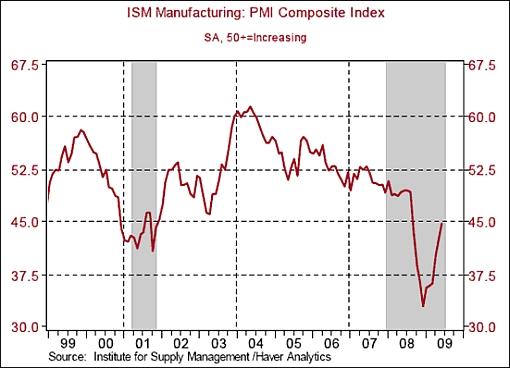
Source: Asha Bangalore, Northern Trust - Daily Global Commentary, July 1, 2009.
Asha Bangalore (Northern Trust): Auto sales fell slightly in June, but Q2 sales rose
“Sales of autos fell to 9.7 million units in June from 9.9 million in May. However, in the second quarter, auto sales have risen at an annual rate of 5.2% versus a 28.3% annualized drop in the first quarter. This will mark the first quarterly increase in auto sales since the last quarter of 2007 (+1.1%), which bodes positively for consumer spending and headline GDP of the second quarter.”
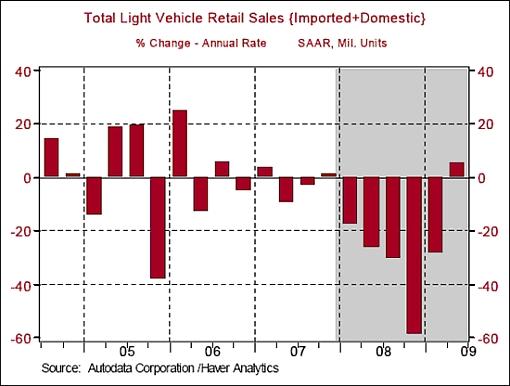
Source: Asha Bangalore, Northern Trust - Daily Global Commentary, July 1, 2009.
The Wall Street Journal: Car makers see end to sales slide
“The three biggest car makers in America called a bottom to the long decline in US auto sales as the industry reported its smallest monthly sales drop this year.
“New-vehicle sales in June fell 28% from a year earlier to 860,000 cars and light trucks, according to the market-research firm Autodata Corp. That would be the smallest decline in any month this year.
“‘We believe the industry is moving beyond the bottom,’ said Bob Carter, group vice president of Toyota Motor Co. in the US. ‘The weak economy’s grip on the auto industry appears to be lessening.’”
Source: The Wall Street Journal, July 2, 2009.
Standard & Poor’s: Case-Shiller Home Price Indices - pace of home price declines moderate
“Data through April 2009, released today by Standard & Poor’s for its S&P/Case-Shiller Home Price Indices, show that, although still negative, the annual decline of the 10-City and 20-City Composites improved.
“The chart below depicts the annual returns of the 10-City Composite and the 20-City Composite Home Price Indices. The 10-City and 20-City Composites declined 18.0% and 18.1%, respectively, in April compared to the same month in 2008. These are improvements over their returns reported for March, down 18.7% for both indices. For the past three months, the 10-City and 20-City Composites have recorded an improvement in annual returns. Record annual declines were reported for both indices with their respective January data, -19.4% for the 10-City Composite and -19.0% for the 20-City Composite.
“‘The pace of decline in residential real estate slowed in April,’ says David Blitzer, Chairman of the Index Committee at Standard & Poor’s. ‘In addition to the 10-City and 20-City Composites, 13 of the 20 metro areas also saw improvement in their annual return compared to that of March.’”
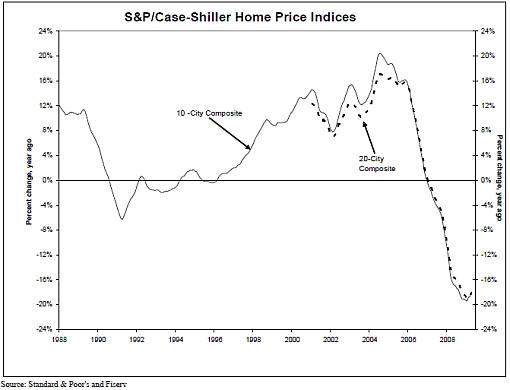
Source: Standard & Poor’s, June 30, 2009.
Barry Ritholtz (The Big Picture): Case-Shiller - 100-year chart
“Regular The Big Picture reader Steve Barry created a 100-year Case-Shiller chart last year which projected forward the ongoing housing losses. Below is Steve’s most recent version.”
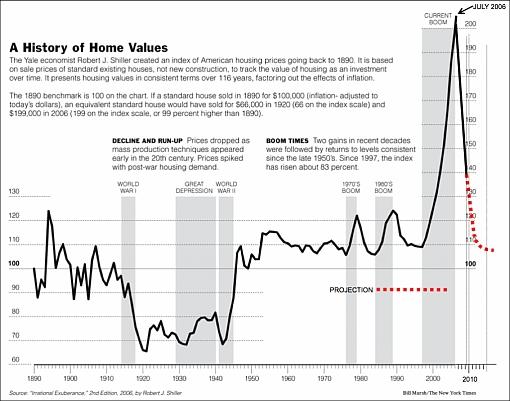
Source: Barry Ritholtz, The Big Picture, July 1, 2009.
Asha Bangalore (Northern Trust): Pending Home Sales Index advances for fourth straight month
“The Pending Home Sales Index (PHSI) of the National Association of Realtors increased 0.1% in May, which is a small but noteworthy fourth consecutive monthly increase. PHSI captures the number of home sales contracts pending to be closed in the following 1-2 month period. The string of four monthly gains of the PHSI augurs positively for sales of existing homes in the June-July months.”
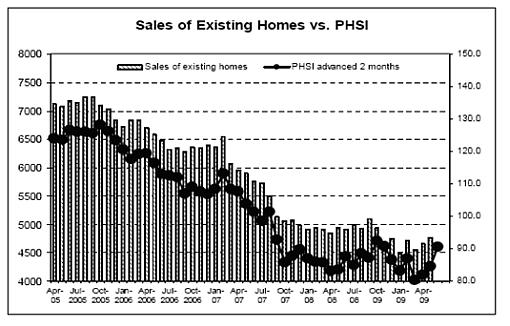
Source: Asha Bangalore, Northern Trust - Daily Global Commentary, July 1, 2009.
Bloomberg: Delinquencies double on least-risky loans
“Delinquency rates on the least-risky mortgages more than doubled in the first quarter from a year earlier as US efforts to help homeowners failed to keep pace with job losses that pushed more borrowers toward foreclosure.
“Prime mortgages 60 days or more past due climbed to 2.9% of such loans through March 31 from 1.1% at the same point in 2008, the Office of the Comptroller of the Currency and the Office of Thrift Supervision said today in a report. First-time foreclosure filings on the loans rose 22% from the fourth quarter, the report said.
“‘I’m very concerned about the rise in delinquent mortgages and foreclosure actions,’ Comptroller of the Currency John Dugan said in a statement with the report. President Barack Obama’s plan to create ’sustainable, payment-reducing modifications is a positive step that should show significant benefits in the coming months,’ Dugan said.
“Obama’s program, unveiled February 18, aims to help as many as 4 million homeowners by modifying loans and calls for Fannie Mae and Freddie Mac to refinance mortgages for as many as 5 million borrowers who owe more than their houses are worth. Foreclosure filings surpassed 300,000 for a third straight month in May, according to RealtyTrac., and the US economy has shed about 6 million jobs since the recession began in 2007.”
Source: Margaret Chadbourn, Bloomberg, June 30, 2009.
Asha Bangalore (Northern Trust): Labor market report - details less bearish than headlines
“Household Survey - The jobless rate inched up to 9.5% in June from 9.4% in May. The unemployment rate is a lagging indicator which is most likely to peak in 2010. In June, the broad measure of unemployment (includes those working part-time because they cannot find full-time jobs and those not looking for work but want and are available in addition to those included in the tally of unemployed in the headline jobless rate) increased to 16.5% from 16.4% in the prior month.
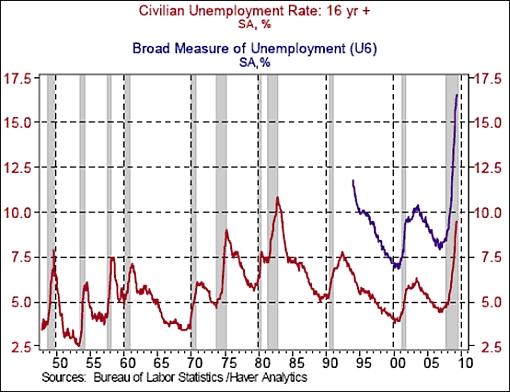
“Establishment Survey: Nonfarm payrolls fell 467,000 in May after an upwardly revised 322,000 decline in May. The April and May revisions of payroll employment led to a net increase of 8,000 jobs. The headline number includes a loss 49,000 government jobs related to the 2010 Census.
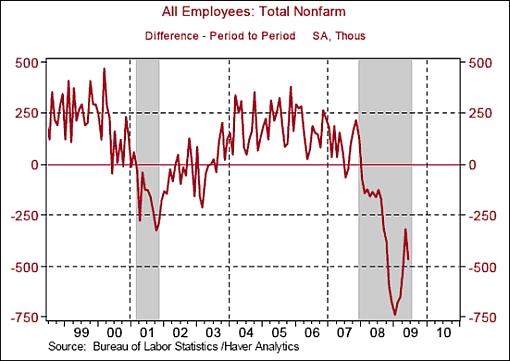
“The path of economic recovery is not a straight line; ups and downs in hiring are part and parcel of the expected trajectory of employment. Stepping back in time, payroll employment showed a firm trend only in 1993 (+2.1 million jobs) although the 1990-1991 recession ended in March 1991. Payroll jobs declined in 1991 (-1.106 million) and rose only 338,000 in 1992, reflecting tepid quarterly gains. After the 2001 recession, hiring gathered momentum only in the fourth quarter of 2003.
“Therefore, it is important to note that payroll growth occurs well after a recession has ended. At the present time, the recession has not ended yet and it follows that it is premature to see significant gains in employment in the near term. In fact, it is noteworthy that on a quarterly average basis, payroll employment fell 1.551 million in the second quarter compared with a loss of 2.065 million jobs in the first quarter of 2009.”
Source: Asha Bangalore, Northern Trust - Daily Global Commentary, July 2, 2009.
CNBC: Mounting jobless claims force states to borrow funds
“Fifteen states have depleted their unemployment insurance funds so far, forcing them to borrow from the US Treasury.
“A record 30 of the country’s 50 states are expected to have to borrow up to $17 billion by next year, said Rick McHugh of the National Employment Law Project, a nonpartisan advocacy group.
“‘We are setting the stage for big pressures for states to restrict eligibility and benefit levels,’ McHugh said. ‘Those type of restrictive actions undercut the (Depression-era program’s) economic and social stability purposes.’
“The state-run unemployment insurance programs are normally financed with payroll taxes paid by employers on each worker. But the funds’ tax revenues are falling at the same time as benefit demands are rising.
“Nine million Americans are receiving jobless benefits, triple the number who got checks at the beginning of the year. Experts predict the number of recipients will peak sometime this summer as long-term unemployed run out of benefits, which were recently extended and last for 59 weeks in most cases.”
Source: CNBC, June 26, 2009.
Asha Bangalore (Northern Trust): Consumer Confidence Index slips in June
“The Consumer Confidence Index fell to 49.3 in June from 54.8 in the prior month. Both the Present Situation Index (24.8 versus 29.7 in May) and the Expectations Index (65.5 versus 71.5 in May) fell in June.
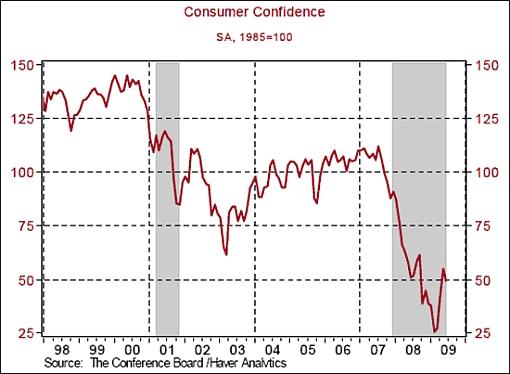
“The outlook about the job market turned pessimistic with a larger percentage of respondents indicating that it is hard to find jobs in June versus May (44.8 versus 43.9 in May) and a fewer percentage of respondents noting that jobs are plentiful (4.5 versus 5.8 in May).”
Source: Asha Bangalore, Northern Trust - Daily Global Commentary, June 30, 2009.
BCA Research: Jump in US income bodes well for spending
“Tax cuts, aggressive monetary easing and some pent up demand suggest that consumer spending should grow at least modestly in the coming quarters, now that the saving rate has adjusted higher.
“Personal spending rose 0.3% in May, as households saved most of a 1.4% boost to income from government social payments and tax cuts (the saving rate rose to almost 7%). The ability of the equity market to advance hinges importantly on consumer spending. A modest upturn in spending would provide investors with greater confidence that the economy will not lapse back into recession in 2010.
“It is always difficult to see how consumers will boost spending when payrolls are shrinking, especially given the tremendous loss of wealth. However, in a typical recovery consumers become more upbeat on the outlook and spending edges higher. This generates increased income and sets off an inventory restocking phase, which then feeds back into stronger consumer confidence and spending. With a lag, payrolls begin to expand again.
“The chart compares the current recession with the average of past cycles, each aligned with the end of the recession. One difference this time is that real disposable growth income has accelerated before the upturn in consumer spending. The contraction in wages and salaries has been more than offset by lower taxes and government transfer payments. This year’s tax cut has a greater chance of being spent than the one-off rebate checks mailed out last year. The jump in income provides some leeway to increase spending without resorting to credit cards.
“Bottom line: there are good odds that the equity market will benefit in the coming months from better news from the consumer sector.”
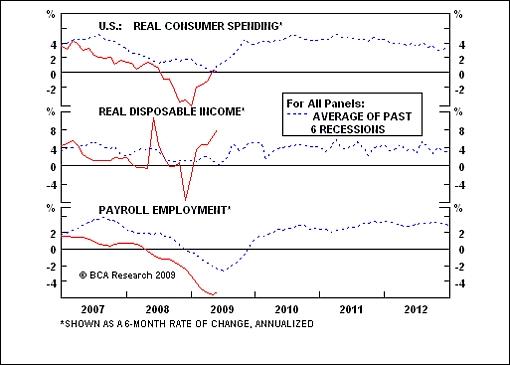
Bespoke: Equities - a wild ride so far
“lf you went to sleep at the end of 2008 and just woke up today, you’d see the S&P 500 up 1.78% for the year and probably assume it’s been a pretty boring six months in the market. Oh how you’d be wrong, however. As shown below, the market has taken investors for a wild ride so far this year. On March 9, the index closed the day down 25% for the year. From March 9 through today’s close, the index has rallied 36%. Down 25% and then up 36% turns into up 1.78% at the midway point.
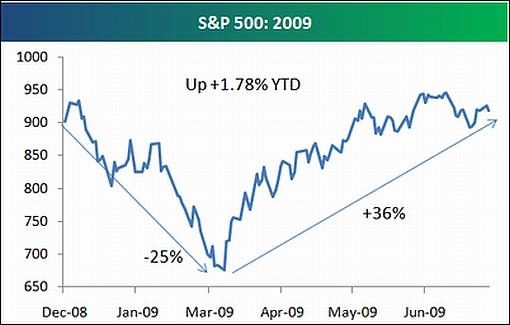
“And while the S&P 500 is up as a whole, only three of the index’s ten major sectors are positive in 2009. Technology has been the big winner so far with a gain of 24.08%. Materials is up the second most at 12.28%, and Consumer Discretionary ranks third at 7.52%. And even though sectors like Industrials and Financials have been going up for months now, both are still down for the year. The Industrials sector is down the most at -7.68%, while Financials are down 4.76%.
“While the year started off horribly for the market, it is heading into July in a nice uptrend even though it has been floundering for a few weeks now. While some investors are getting frustrated with the market’s inability to break to new highs, they easily forget how bad things were just a few months ago. Up 1.78% in ‘09 with everything that has happened - we’ll take it!
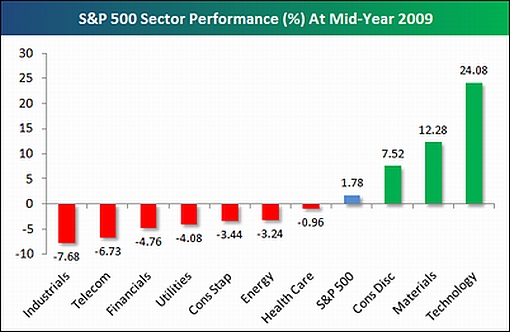
Source: Bespoke, June 30, 2009.
TimesOnline: Ten top investment tips from Mark Mobius
“Dr Mark Mobius is one of the most experienced fund managers in the industry. He has been managing the Templeton Emerging Markets Investment Trust since its launch 20 years ago.
“Here Dr Mobius draws on his years of experience to offer ten investment tips to Money Central readers.
1. Keep an eye on value
Is a share selling for below its book value? What is the relationship between the earnings and the price?
2. Don’t follow the herd
Many of the most successful investors are contrarian investors. Buy when others are selling and sell when others are buying.
3. Be patient
Rome was not built in a day and companies take time to grow to their full potential.
4. Dripfeed your money into the market
No one knows exactly where markets are going so dripfeed your money into the market by making regular investments. That way you will average out the ups and downs of the market.
5. Examine your own situation and your appetite for risk
You should not go into equities if you are the type of person who is nervous every time you read a stock market report.
6. Diversify your portfolio
You must never put all your eggs in one basket unless you have a lot of time to watch that basket - and most of us don’t.
7. Don’t listen to your friends or neighbours when it comes to making investment decisions
Your own situation is different from everyone else’s so you should be making the decisions.
8. Don’t believe everything you read in newspapers, because things tend to be exaggerated
Don’t be swayed by headlines and look at what is going on behind the scenes.
9. Go into emerging markets because that is where the growth is
Emerging markets have consistently grown much faster than the developed countries in virtually every year since 1988.
10. Look at countries where populations are relatively young
Countries with young populations are going to be the most productive in future years.”
Source: TimesOnline, June 30, 2009.
Gareth Williams (ING): Peak seen in profit warnings
“The European profits warning cycle looks like it has peaked, boding well for the second quarter results season, according to Gareth Williams, equity strategist at ING.
“‘As the first half of the year draws to a close, the tally of profit warnings so far in 2009 stands at 65,’ he says.
“‘This is less than half of the 142 total recorded in the second half of 2008 and is also lower than the comparable first half figures for both 2007 and 2008.’
“But the improvement needs to be placed in the context of a number of companies abandoning profit guidance altogether, as well as greatly reduced expectations.
“‘Twelve-month forward earnings forecasts have been cut by around 40% over the last year.’
“Even so, current warnings trends point to a shorter downturn than in 2001-03, he says.
“At the rate implied by the first half, the number of warnings in the whole of 2009 looks set to come in at 138, 35% lower than in 2008 and back to pre-crisis levels.
“Mr Williams says an analysis of warnings by size reveals that mid-cap stocks are still suffering, in contrast to an improving picture for large and small caps. “‘We would attribute this to a greater degree of domestic cyclicality within mid-caps.’
“Profit warnings are addictive, he says. ‘Nearly half of the large-cap stocks warning this year warned last year too.’”
Source: Gareth Williams, ING (via Financial Times), June 29, 2009.
By Dr Prieur du Plessis
Dr Prieur du Plessis is an investment professional with 25 years' experience in investment research and portfolio management.
More than 1200 of his articles on investment-related topics have been published in various regular newspaper, journal and Internet columns (including his blog, Investment Postcards from Cape Town : www.investmentpostcards.com ). He has also published a book, Financial Basics: Investment.
Prieur is chairman and principal shareholder of South African-based Plexus Asset Management , which he founded in 1995. The group conducts investment management, investment consulting, private equity and real estate activities in South Africa and other African countries.
Plexus is the South African partner of John Mauldin , Dallas-based author of the popular Thoughts from the Frontline newsletter, and also has an exclusive licensing agreement with California-based Research Affiliates for managing and distributing its enhanced Fundamental Index™ methodology in the Pan-African area.
Prieur is 53 years old and live with his wife, television producer and presenter Isabel Verwey, and two children in Cape Town , South Africa . His leisure activities include long-distance running, traveling, reading and motor-cycling.
Copyright © 2009 by Prieur du Plessis - All rights reserved.
Disclaimer: The above is a matter of opinion and is not intended as investment advice. Information and analysis above are derived from sources and utilizing methods believed reliable, but we cannot accept responsibility for any trading losses you may incur as a result of this analysis. Do your own due diligence.
Prieur du Plessis Archive |
© 2005-2022 http://www.MarketOracle.co.uk - The Market Oracle is a FREE Daily Financial Markets Analysis & Forecasting online publication.



